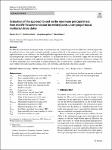Item Infomation
Full metadata record
| DC Field | Value | Language |
|---|---|---|
| dc.contributor.author | Fass, Markus | - |
| dc.contributor.author | Hecht, Matthias | - |
| dc.contributor.author | Baumgartner, Jörg | - |
| dc.date.accessioned | 2023-10-06T09:34:15Z | - |
| dc.date.available | 2023-10-06T09:34:15Z | - |
| dc.date.issued | 2023 | - |
| dc.identifier.uri | https://dlib.phenikaa-uni.edu.vn/handle/PNK/9502 | - |
| dc.description | CC-BY | vi |
| dc.description.abstract | The IIW-Recommendation for fatigue design of welded joints and components presents two different evaluation approaches for multiaxial stress states under constant amplitude: an approach based on the maximum principal stress, which is only applicable under certain conditions, and the Gough-Pollard approach for the remaining cases. In the course of this work, this maximum principal stress-based approach is analyzed. It is examined in which cases the method is applicable, the advantages and disadvantages compared to the approach according to Gough-Pollard are discussed, and an evaluation according to the von Mises equivalent stress is presented as a third alternative. This is followed by a validation based on literature data on laser-welded steel joints using the nominal stress, hot spot stress, and effective notch stress concept. | vi |
| dc.language.iso | en | vi |
| dc.publisher | Springer | vi |
| dc.subject | IIW-Recommendatio | vi |
| dc.subject | Gough-Pollard | vi |
| dc.title | Evaluation of the approach based on the maximum principal stress from the IIW-Recommendation for welded joints under proportional, multiaxial stress states | vi |
| dc.type | Book | vi |
| Appears in Collections | ||
| OER - Khoa học Vật liệu, Ứng dụng | ||
Files in This Item:

